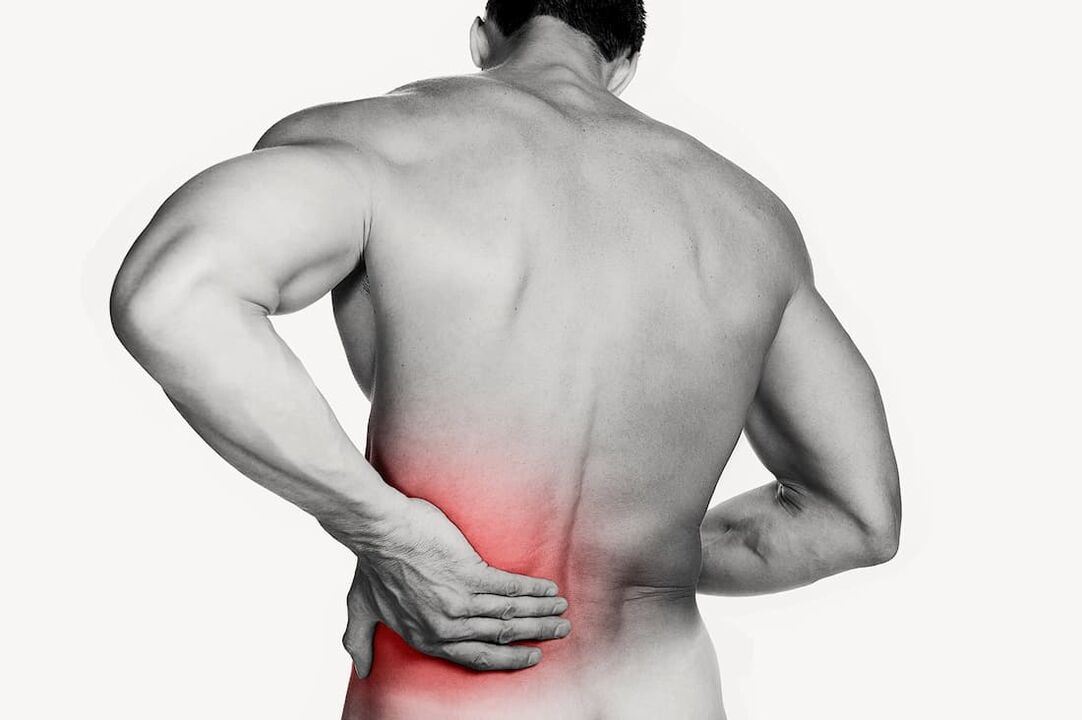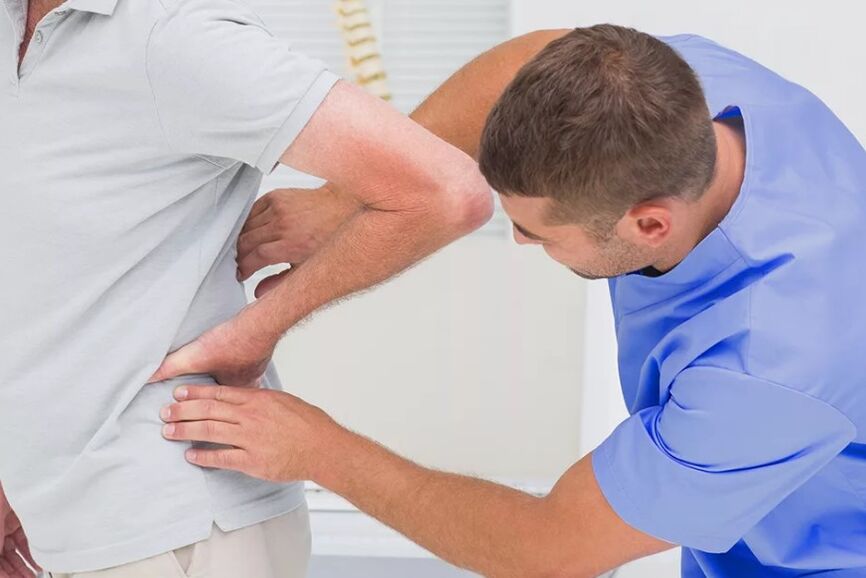
Low pain is the symptom that is rarely paid.Most people associate it with work in a sitting position, raising weights or osteochondrosis and is not in a hurry to consult a doctor.In fact, this condition can signal the diseases of the kidneys, liver or intestines and problems with the musculoskeletal system will not pass alone.Only an overwhelming inspection of an expert and a complete exam will help identify the cause of pain and choose the right treatment.
general information
The lumbar region is an area that experiences a significant load due to being in the upright position.The spine of the spine is represented by five large vertebrae, which are additionally strengthened by the muscle structure.9 of the 10 cases of pain in this area are caused precisely by the pathology of the musculoskeletal system: osteochondrosis, muscle spasm, intervertebral disc hernia, pinching nerve root.
The remaining 10% of cases are associated with internal organ diseases located in the projection of the lumbar region: kidneys, genitourinary system, intestines, liver.Even a doctor, when examining, cannot always determine the cause of pain, which is why this condition requires a complete laboratory and instrumental diagnosis.
Pain types
The first thing the doctor asks is the nature of sensations.Depending on the cause it caused, lower back pain can be:
- Acute: Generally arose markedly, characterized by high intensity;The duration of sensations is not exceeding 1.5 months;
- Subacute: lasts from 6 to 12 weeks;
- Chronic: Sensations of any intensity that lasts 12 weeks or more;
- Transfer (variable): appears periodically;
- sore;
- dumb;
- Strong and medium, weak intensity.
This division is conditional.Depending on the situation and circumstances, the nature and duration of sensations may vary.It is important to describe them as fully as possible.
Reasons
The reasons for which the back begins to hurt in the lower back.Most of the time, provocative factors serve:
- hypothermia;
- weight lifting;
- Unequal load distribution (against pregnancy antecedents, posture disorders, musculoskeletal system pathology);
- infectious injury;
- musculoskeletal diseases;
- inflammatory processes, including autoimmune;
- long stay in an uncomfortable position;
- Change in bone tissue composition (osteoporosis);
- Volumetric processes: benign and malignant tumors, abscesses;
- hormonal changes (menstruation, pregnancy, menopause);
- kidney diseases (urolithiasis, pyelonephritis, glomerulonephritis, abscesses);
- gastrointestinal tract pathology;
- Uterus diseases and appendages in women, prostate in men, etc.
Illnesses
Low pain may be a symptom of various diseases of the musculoskeletal system and internal organs.The doctor's main task is to find out what exactly caused the condition deterioration and take the necessary measures.
Here are the most common pathologies.
Ankylosing spondylitis
This is a systemic inflammatory disease, in which individual vertebrae occurs in a single conglomerate.At the same time, calcium deposit occurs in ligaments stabilizing the spine, as a result of which the affected area almost completely loses mobility.
The distinct characteristics of lumbar pain with ankylosing spondylitis include:
- an increase in rest intensity, especially with prolonged findings in horizontal position;
- restriction of movements in the lower back;
Lumbar spine osteochondrosis
This is a very common disease in which intermittent discs are thinner, playing the role of shock absorbers.As a result, the nerve roots and the cramps of the surrounding muscles that cause intense pain are irritated.In the late stage of the disease, an intervertebral hernia is formed, which can press the spinal cord, increasing pain.
With osteochondrosis, the pain intensifies:
- When raising from a sedentary or horizontal position;
- When trying to lie in the stomach;
- With inclinations.
If the disease causes the formation of a massive hernia, pain in the lower back is often accompanied by numbness and weakness of one or both legs.
The curvature of the spine in the lower back (kyphosis, scoliosis)
Pain in this pathology occurs in the middle and late stage of disease development.The discomfort usually occurs until the end of the day and is often accompanied by fatigue of the spine muscles.Pain is more often caused by the cramps of the spine muscles, and it is also possible to explore the muscles in removal (thin and lower -end sperm muscles).
Spondylartrosis
This is a degenerative-distribution disease of the cartilage, covering intervertebral discs.It is gradually thinner and destroyed, bone growth (osteophytes) appear around the lesion area.As a result of a reduction in distance between the vertebrae, the narrow spinal canal, the nerve roots and the spinal cord are irritated.
Pain with this pathology:
- Intensifies after load (long -term stay in standing position, walking) and passes after rest;
- accompanied by the rigidity of the movements, first in the morning, then constant;
- It can be given to the thigh and hip joint area.
The muscles in the lesion area are spasmodic and constantly in tension, which also increases pain.
Uroline disease
An attack of urolithiasis is characterized by intense lumbar pain of the affected kidney.At the same time, sensations do not change, depending on the pose, a person cannot find a position in which they are at least a little weakening.The attack is often accompanied by a reduction in the amount of urine and a change in its color to the reddish.
Low pain can also be a consequence:
- Algomenor (painful menstruation);
- pregnancy;
- pancreatic inflammation;
- osteomyelitis;
- intestinal obstruction;
- Appendicitis, etc.
Pain in various parts of the back
The location of the pain can say a lot about your cause.Pain in the top of the lower back can be a consequence:
- spine diseases;
- injuries;
- muscle spasm against the bottom of their overvoltage;
- cardiovascular diseases;
- Tumors;
- Gastrointestinal tract diseases.
If the epicenter is located at the bottom of the lower back, the list of probable reasons will include, in addition to spine diseases:
- Renal pathology (pyelonephritis, urolithiasis);
- intestinal rupture (constipation, flatulence);
- spasms or inflammatory process in the pelvic organs (salpingoofarita, endometritis);
- Physiological causes, in particular, pregnancy;
- Pinching the sciatic nerve.
The displacement of the pain on the right or left may indicate the corresponding spine lesion of the spinal cord, the kidneys.
Diagnosis
The diagnosis of lumbar pain requires a comprehensive examination.The first stage of the search for the reason is the research.The doctor clarifies:
- Pain location;
- its character and duration;
- Causes that cause an attack or improve pain;
- Circumstances in which the condition improves (a certain pose, immobility, drug use, etc.).
Data on injuries and diseases, already identified chronic pathologies are collected without failure.Another possible diagnostic research at the doctor's discretion includes:
- General Blood and Urine Test: Helps identify the inflammatory process in the body, renal pathology;
- Biochemical blood examination to identify signs of kidney, pancreas, liver and gallbladder, etc.;
- Ultrasound of the abdominal organs and pelvis in men - ultrasound of the prostate gland;
- Kidney ultrasound;
- Radiography, CT or magnetic resonance imaging of the lumbar spine;
- X -chest range.
In case of suspicion of any pathology after a diagnosis and review of the review, more targeted tests, examinations and consultations of narrow specialists are prescribed.They allow you to clarify or refute the diagnosis.

Treatment
The treatment of pain in the lower back depends on your cause.A neurologist, a urologist, a gynecologist, and a surgeon can get involved in a pathology.If we are talking about diseases of the musculoskeletal system, doctors use methods, non -drug and surgical methods to improve the patient's condition.
Drug treatment
The most common means of eliminating lumbar pain are non -esteroid anti -inflammatory drugs (NSAIDs).They are prescribed in the form of tablets, intravenous and intramuscular injections, rectal suppositories, as well as creams, ointments and brlase for local use.The decision on the dosage of the product, as well as the duration of the course, is taken by the doctor, since uncontrolled use of these medications can cause unpleasant side effects.
If NSAIDs are ineffective, doctors prescribe hormonal drugs (corticosteroids).They also interrupt the inflammatory process and help reduce pain.
The third group of drugs that improve the patient's condition is the antispasmodic.They remove muscle cramps in the lower back.
In addition, they can be named:
- decongestants to reduce the edema of a compressed root;
- B vitamins to improve nerve conduction;
- sedatives.
No -Drug Methods
No -DRURG treatment complements medicinal schemes.Depending on the clinical situation, it may include:
- Physiotherapeutic procedures (magnetotherapy, laser effect, electrophoresis etc.);
- Physiotherapy Exercises: The course of exercises is developed individually according to the main and related diseases;Gymnastics should be performed regularly, not only in the clinic's office, but also at home, only in this case has an effect;
- General strengthening and therapeutic massage (performed outside the exacerbations);
- acupuncture;
- Manual therapy and osteopath assistance.
Surgical treatment
The surgeon's help is necessary if the assistant physician based on the general condition reveals one of the indications for surgical treatment.The presence of an intervertebral hernia is not an indication for surgical treatment, regardless of its size.Depending on the indications, doctors can remove the hernia from the intervertebral disc, eliminate compression from spinal cord roots, remove the tumor, etc.The decision to conduct a specific operation is done individually.
Prevention
The most effective way to avoid lower back pain is to adjust your lifestyle to save the kidneys, the spine and the pelvic organs, but if the pain has usually arisen, this should be the reason for an extraordinary appeal to an expert:
- Avoid hypothermia;
- prevent hypodinâmia;
- Sports of playing at an amateur level (swimming is especially beneficial affects the condition of the spine and the muscles of the back);
- Correct and balanced to eat: avoid eating too much, minimizing fatty, spicy and excessively salty foods;
- exclude alcohol and nicotine;
- Drink at least 1.5 liters of pure water daily without considering tea, coffee or juices;
- Keep body mass index at a normal level: overweight does not affect the condition of the spine and deficiency can cause kidney veneration.
If a person has already diagnosed the pathology of the muscle system, preferably at least twice a year, according to European recommendations for rehabilitation of the column pathology, to be subjected to preventive courses according to the appointment of a doctor.






















